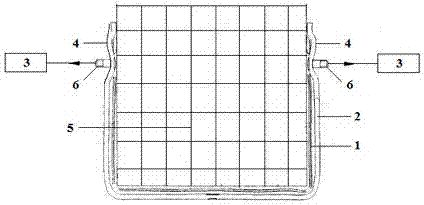Thermoforming method of co-woven continuous fiber reinforced thermoplastic structural plate
A technology for reinforcing thermoplastic and structural panels, which is applied in the field of continuous fiber reinforced thermoplastic composite materials, which can solve the problems of mixed fiber resin bonding, influence of prepreg performance, and performance degradation of finished products, so as to reduce resin components, improve adaptability, and reduce loss Effect
- Summary
- Abstract
- Description
- Claims
- Application Information
AI Technical Summary
Problems solved by technology
Method used
Image
Examples
Embodiment 1
[0026] Glass fiber S reinforced polypropylene prepreg and glass fiber E reinforced polypropylene prepreg, the weight ratio is 1:2. Two prepregs with a width of 0.1m were placed on the creel of the weaving machine to weave evenly, and the two prepregs were woven into a mesh prepreg tape with a width of 1.2m. The glass fiber E reinforced polypropylene prepreg is the main body in the prepreg tape, and the glass fiber S reinforced polypropylene prepreg is uniformly dispersed in it.
[0027] Such as figure 1 As shown, cut the prepreg tape 1 to the same size as the mold 5, lay it in the mold 5, and cover it with a vacuum bag 2 (or polyester film). The size of the vacuum bag 2 is larger than the size of the mold 5. Fix and seal with clamping and sealing device 4, vacuum nozzle 6 is preset on vacuum bag 2, and its position is determined according to the shape of the mould. Connect the vacuum nozzle 6 to a vacuum pump or other vacuuming device 3, start electric heating (or oil heatin...
Embodiment 2
[0030] Carbon fiber reinforced nylon 1010 prepreg and glass fiber reinforced nylon 1010 prepreg, the weight ratio is 5:2. Two kinds of prepregs with a width of 0.1m were respectively placed on the creel of the weaving machine to weave evenly, and the two kinds of prepregs were woven into a sheet-like prepreg tape with a width of 1.4m. In the prepreg, the carbon fiber reinforced nylon 1010 prepreg is the main body, and the glass fiber reinforced nylon 1010 prepreg is uniformly dispersed therein.
[0031] Cut the prepreg tape to the same size as the mold, lay it in the mold, cover it with a vacuum bag (or polyester film), the size of the vacuum bag is larger than the size of the mold, fix and seal the periphery of the vacuum bag with a clamping sealing device, The vacuum nozzle is preset on the vacuum bag, and its position is determined according to the shape of the mold. Connect the vacuum nozzle to the vacuum pump (or other vacuuming device), start electric heating (or oil he...
PUM
 Login to View More
Login to View More Abstract
Description
Claims
Application Information
 Login to View More
Login to View More - R&D
- Intellectual Property
- Life Sciences
- Materials
- Tech Scout
- Unparalleled Data Quality
- Higher Quality Content
- 60% Fewer Hallucinations
Browse by: Latest US Patents, China's latest patents, Technical Efficacy Thesaurus, Application Domain, Technology Topic, Popular Technical Reports.
© 2025 PatSnap. All rights reserved.Legal|Privacy policy|Modern Slavery Act Transparency Statement|Sitemap|About US| Contact US: help@patsnap.com


